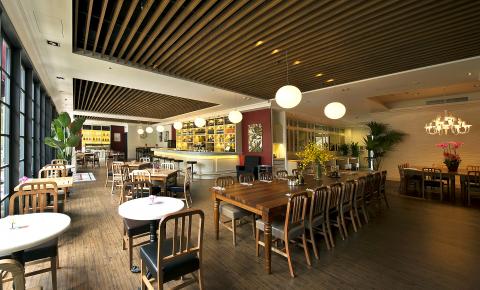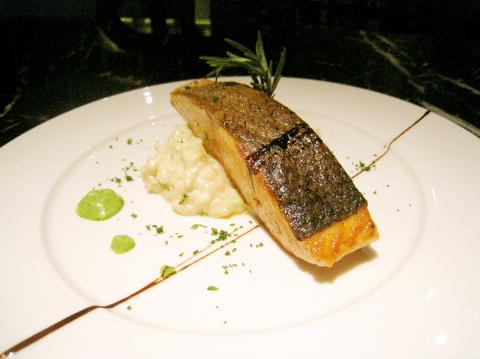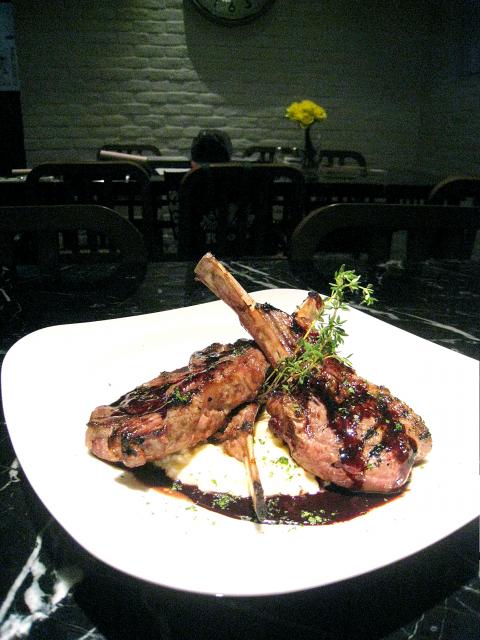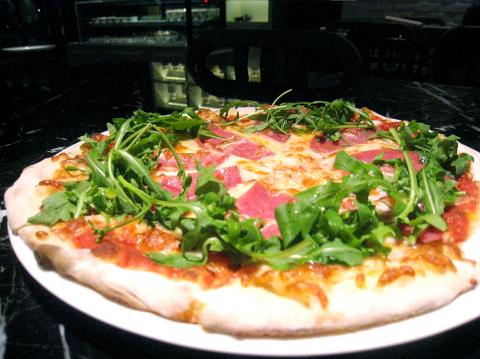Longtable, which has recently opened up in a leafy enclave hidden behind the stern office buildings along Songren Road at the eastern fringe of the Xinyi cinema and shopping district, provides something that is in very short supply in Taipei’s cost-conscious restaurant environment, namely a big, comfortable and airy space to eat and chat.
Walking through the door, this spaciousness is the first thing you notice, quickly followed by the warm tones imparted by an interior decorated mostly in natural wood tones. The high ceiling and the long bar are inviting, though on a fine day, the patio seating, looking onto a paved courtyard overhung with trees, is likely to be in high demand.
The ambiance is somewhere between a fashionable cafe and a bistro. This provides a welcome alternative to the predominantly American diner establishments that dominate in this area. The menu, instead of going for burgers and steaks, offers something a little more European. While aiming for a casual dining experience, Longtable also takes some trouble over providing elegance and refinement at the same time.

Photo courtesy of Longtable
According to restaurant proprietor Serdar Gayir, the menu aims to be inclusive, drawing in food from all along the Mediterranean coast. Italian, with a bit of generic European, dominate the menu at the present time, but Gayir said that once the restaurant is on track, he will begin including more exotic choices, including food from North Africa and even his native Turkey. Currently, his home country is represented by a rice pudding (NT$220). This has a luscious creaminess of homemade comfort food with lovely presentation, but lacks a little something to make it really distinctive.
Looking through the menu, one gets the feeling that Longtable wants to make a break from the drab, predictable fast foods that are the mainstay of establishments such as TGI Fridays and Chilis, but also desperately wants to remain family-friendly and inoffensive to even the most timid eater. The fried chicken wings (NT$290), the Caesar salad (NT$360), the spaghetti Bolognese (NT$370) and the grilled sirloin steak (NT$930) are all resolutely international staples, with no clear regional affiliation, and this gives the menu a slightly jejune air.
This is no reflection of the standard of the cooking, which is above average, and a simple dish like the pan-fried salmon fillet (NT$590) was attractive and tasty. The presentation was modern, but the portion generous, and the risotto on which the salmon was served was judged to perfection. The grilled lamb chops (NT$830), also served with risotto, also came in a generous portion, three thick chops very well trimmed, but flavor-wise again playing a little bit too safe for my taste. I regretted the lack of a bit of crispy fat and found the sauce, a tasty, red wine reduction, a bit too dominant, smothering the meaty flavor of the lamb.

Photo: Ian Bartholomew, Taipei Times
Longtable offers a selection of pizzas, and the pepperoni pizza (NT$430) I tried was well topped with a very thin crust dough, which sadly had not been crisped up quite enough.
Longtable aspires to be a place where people can come together to eat and drink at leisure and its solid menu of drinks, both alcoholic and nonalcoholic, are likely to make it a popular gathering place, both for weary office workers and for families on a weekend outing. Gayir said that Longtable is also planning on providing breakfast/brunch through the week, and a comprehensive offering of coffees and teas make it a great place to visit any time of day. For the festive season, Longtable offers a five-course set menu (with coffee or tea) for NT$1,390.

Photo: Ian Bartholomew, Taipei Times

Photo: Ian Bartholomew, Taipei Times

The Lee (李) family migrated to Taiwan in trickles many decades ago. Born in Myanmar, they are ethnically Chinese and their first language is Yunnanese, from China’s Yunnan Province. Today, they run a cozy little restaurant in Taipei’s student stomping ground, near National Taiwan University (NTU), serving up a daily pre-selected menu that pays homage to their blended Yunnan-Burmese heritage, where lemongrass and curry leaves sit beside century egg and pickled woodear mushrooms. Wu Yun (巫雲) is more akin to a family home that has set up tables and chairs and welcomed strangers to cozy up and share a meal

Dec. 8 to Dec. 14 Chang-Lee Te-ho (張李德和) had her father’s words etched into stone as her personal motto: “Even as a woman, you should master at least one art.” She went on to excel in seven — classical poetry, lyrical poetry, calligraphy, painting, music, chess and embroidery — and was also a respected educator, charity organizer and provincial assemblywoman. Among her many monikers was “Poetry Mother” (詩媽). While her father Lee Chao-yuan’s (李昭元) phrasing reflected the social norms of the 1890s, it was relatively progressive for the time. He personally taught Chang-Lee the Chinese classics until she entered public

Last week writer Wei Lingling (魏玲靈) unloaded a remarkably conventional pro-China column in the Wall Street Journal (“From Bush’s Rebuke to Trump’s Whisper: Navigating a Geopolitical Flashpoint,” Dec 2, 2025). Wei alleged that in a phone call, US President Donald Trump advised Japanese Prime Minister Sanae Takaichi not to provoke the People’s Republic of China (PRC) over Taiwan. Wei’s claim was categorically denied by Japanese government sources. Trump’s call to Takaichi, Wei said, was just like the moment in 2003 when former US president George Bush stood next to former Chinese premier Wen Jia-bao (溫家寶) and criticized former president Chen

President William Lai (賴清德) has proposed a NT$1.25 trillion (US$40 billion) special eight-year budget that intends to bolster Taiwan’s national defense, with a “T-Dome” plan to create “an unassailable Taiwan, safeguarded by innovation and technology” as its centerpiece. This is an interesting test for the Chinese Nationalist Party (KMT), and how they handle it will likely provide some answers as to where the party currently stands. Naturally, the Lai administration and his Democratic Progressive Party (DPP) are for it, as are the Americans. The Chinese Communist Party (CCP) is not. The interests and agendas of those three are clear, but